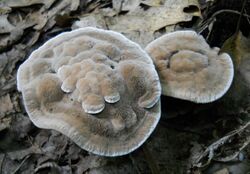Biology:Hydnellum spongiosipes
From HandWiki
Short description: Species of fungus
| Hydnellum spongiosipes | |
|---|---|

| |
| Scientific classification | |
| Domain: | Eukaryota |
| Kingdom: | Fungi |
| Division: | Basidiomycota |
| Class: | Agaricomycetes |
| Order: | Thelephorales |
| Family: | Bankeraceae |
| Genus: | Hydnellum |
| Species: | H. spongiosipes
|
| Binomial name | |
| Hydnellum spongiosipes (Peck) Pouzar (1960)
| |
| Synonyms[1] | |
| |
Hydnellum spongiosipes, commonly known as the velvet tooth,[2] is a tooth fungus in the family Bankeraceae. It is found in Europe and North America.[3] In Switzerland, it is considered a vulnerable species.[4]
Taxonomy
The fungus was originally described as new to science in 1898 by American mycologist Charles Horton Peck, who placed it in the genus Hydnum.[5] Zdeněk Pouzar transferred it to Hydnellum in 1960.[6] Synonyms include Hydnellum nuttallii, published by Howard James Banker in 1906, and Hydnellum velutinum var. spongiosipes, published by Rudolph Arnold Maas Geesteranus in 1957.[1]
References
- ↑ 1.0 1.1 "GSD Species Synonymy: Hydnellum spongiosipes (Peck) Pouzar". Species Fungorum. CAB International. http://www.speciesfungorum.org/GSD/GSDspecies.asp?RecordID=332093.
- ↑ "Recommended English Names for Fungi in the UK". British Mycological Society. http://www.fungi4schools.org/Reprints/ENGLISH_NAMES.pdf.
- ↑ British Chanterelles and Tooth Fungi. Kew, UK: Royal Botanic Gardens. 1997. pp. 88–89. ISBN 978-1-900347-15-0.
- ↑ (in Italian) Lista Rossa Macromiceti. Lista Rossa delle specie minacciate in Svizzera. UV-0718-I (Report). Bern: Ufficio federale dell’ambiente. 2007. http://www.bafu.admin.ch/publikationen/publikation/00055/index.html?lang=fr&lang=it.
- ↑ Peck CH. (1897). "Report of the State Botanist (1896)". Annual Report on the New York State Museum of Natural History 50: 77–159 (see p. 111).
- ↑ Pouzar Z. (1960). "The Kersko forest in the Central Elbe Region". Ceská Mykologie 14 (2): 129–32.
External links
Wikidata ☰ Q10527992 entry
 |

